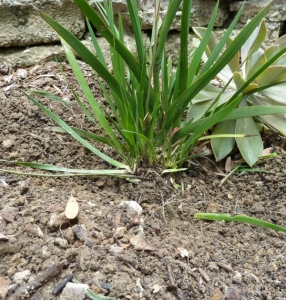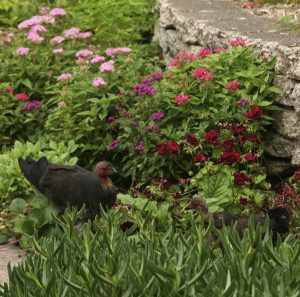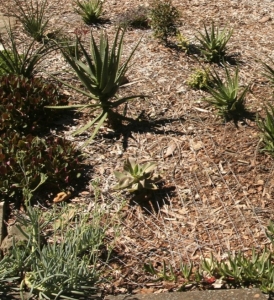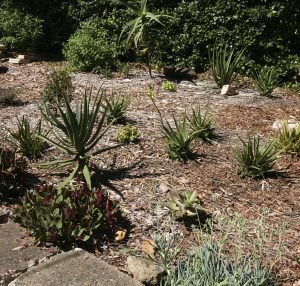Brush turkey, bush turkey or scrub turkey – whatever you want to call them, they are are garden destroyers. I love living in a part of Sydney where I can enjoy our local fauna. We have plenty of possums, the odd echidna, wallaby and goanna, loads of water dragons and a multitude of native birds. They are all welcome in my yard, but learning how to cohabit with brush turkeys is proving my most difficult accommodation yet.

Digging around kangaroo paw exposes roots
I am planting out a new part of my front garden. To improve the soil from the hard-baked clay subsoil rubbish that was put there decades ago when the road was built, I spread some old cow manure and covered it with a thick layer of woodchip mulch, left from the dying bluegum I had to remove early last year. As it’s broken down, the soil has really improved so over the past six months I’ve been planting a somewhat eclectic mix of kangaroo paw, aloe, hesperaloe, crassula, dwarf lillypilly, nandina and lomandra.
It was a few months ago that I first noticed one of the kangaroo paws had a small ditch dug right around it, exposing the roots. Wondering about my cat’s strange new habit, I gave him a good talking to, filled in the ditch and hoped the ‘paw would survive. It was a few days later, when the same destructive force hit but this time on several plants at once that the penny dropped. The inexorable southward march of the gardener-dreaded brush turkey had arrived in my garden.

Brush turkey hen & chick enjoy my garden
Brush turkeys are native to the moist forests of eastern Australia. Baiting in national parks for foxes, an unnatural predator that had decimated turkey numbers, has resulted in a population resurgence, with many reports of brush turkeys moving into the gardens of Sydney’s north over the past few years. They feed on seeds and fallen fruit but also insects, which they search for by scratching up large amounts of soil or mulch. I can see why they are part of the megapodes group of birds, because those big feet can really move some stuff. They are particularly attracted to mulched gardens with nearby large trees, as they roost in trees at night. When they’re not digging…….

Turkey-moved mulch (wildlifeqld.com.au)
So far I’m lucky enough to only have a female and chick, so I don’t have a male’s 4m wide by 2m high nesting mound. But I’ve found a hen and chick can dig up newly planted plants almost as fast as I can get them in the ground so I had to think of something.
Brisbane gardeners have been dealing with the turkeys for years and suggest some interesting deterrents including rubber snakes, mirrors, tall fences and creating an attractive large compost heap as a decoy, although
several experts say that once you have a nest-building male in your garden, attempts to send it elsewhere are usually futile. Note that brush turkeys are a protected species and it’s illegal to harm them, trap them or relocate them. I can’t see how tall fences can work as brush turkeys can, and do fly. I saw one yesterday 4 metres up on the telephone cable outside my house, and here’s one happily munching berries in my Nyssa tree!

As my plants are still small, I’ve opted for a wire-over-mulch treatment. The plants are fairly close together, making a wide roll of wire mesh too unwieldy, so I bought a few rolls of 350mm wide galvanised edging mesh from Bunnings and packs of gal tent pegs. I used tin snips to cut into the wire so I could fit it quite tightly around the base of the plants and I’ve used cut end strands to wire the strips together and lots of tent pegs to make a mesh carpet. I’ll see how this works before I mulch over it again, so at the moment the garden is glinting like it has orthodontic braces. I’ve read that larger turkeys can move house bricks, so I don’t know if my pegging down will be strong enough.
In an old Gardening Australia TV episode, a Brisbane gardener recommended planting Plectranthus amboinicus, or mother-of-herbs, as an aromatic deterrent, so I might try and track it down too.
And a final warning – if you see brush turkeys about, make sure to keep screen doors

Glinting carpet of protecting wire mesh
and windows closed. They are quite likely to wander into your house, with laden fruit bowls and uneaten pet food both special attractions, however when trapped inside they’re inclined to go completely crazy and quickly destroy a room. If you ever get the chance to watch an ABC doco from 2007 called Chant of the Scrub Turkey, it will enlighten you as to this bird’s destructive power, especially what it can do to a peace-loving, ecologically-minded, self-sufficient, Buddhist community in Frog’s Hollow in SE Queensland. As wildlife expert Ric Nattrass said in a SMH interview about Frog’s Hollow:
“What I admire about these birds, is their ability to virtually hospitalise a human being without laying a claw on them.” (SMH 19 June 2007)
For further information about brush turkeys, visit:
NSW Government Office of Environment & Heritage
Birds in Backyards
BRAIN – Brisbane Rainforest Action & Information Network
